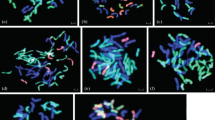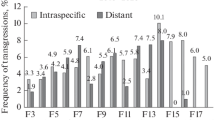Abstract
For the analysis of the results of hybridization during the early stages of wheat breeding, it is important to choose a system of traits by which the selection of elite plants will achieve some genetic progress and lead to improved yield potential. As a rule, when analyzing various factorial traits in the first-generation hybrids, quantitative parameters of plant yield components, their inheritance pattern, and heterosis are determined. A new source material of spring durum wheat was created by intraspecific and interspecific crossings. The inheritance pattern of the main components of spike productivity in the first-generation hybrids of durum wheat has been studied. The inheritance overdominance and partial positive dominance of spike length and grain number per spike was characteristic for the majority (64.3%) of intraspecific F1 hybrids. The best hybrid combination (Melanopus 10-02 × Slavuta) was characterized by overdominance and positive dominance in the inheritance of all the studied traits; high degree of heterosis (DH) (64.7%) by grain weight per spike was noted. Heterosis and inheritance pattern of the “1000 grain weight” trait by overdominance was found in hybrids obtained by crossing Melanopus 10-02 × Slavuta (hp = +5.0; DH +9.9%), Leucurum 06-07 × Saratovskaya zolotistaya (hp = +13.0; DH +7.4%), and Leucurum 06-07 × Kharkivska 29 (hp = +17.0; DH +10.0%). Among the studied parental component, the line Melanopus 10-02 has been selected and submitted to the State Qualifying Examination of the Ukrainian Institute for Plant Variety Examination. It was registered as the novel durum wheat cultivar MІР Raiduzhna. The promising perspective of the intraspecific cross combination (Line 08-17 × Saratovskaya zolotistaya) was noted; these hybrids were characterized by heterosis for all the analyzed traits and overdominance of their inheritance, which allowed recommending this cross for further genetic studies. Therefore, defining the parameters of plant productivity, the inheritance pattern, the degree of heterosis in the first-generation hybrids is an urgent task in creating new varieties as well as in the predicting breeding and genetic effect of crossing.
Similar content being viewed by others
REFERENCES
Andriichenko, L.V. and Muzafarov, I.M., Ways of realization of spring wheat varieties productive potential, Bull. Agrar. Sci. Black Sea Reg., 2007, vol. 4 (43), pp. 216–221.
Beil, G.M. and Atkins, R.E., Inheritance of quantitative characters in grain sorghum, Iowa State J. Sci., 1965, vol. 39, no. 3, pp. 345–348.
Bousalhih, B., Mekliche, L., Aissat, A., et al., Study of genetic determinism of harvest index in durum wheat (Triticum durum Desf.) under semi-arid conditions, Afr. J. Biotechnol., 2016, vol. 15, no. 47, pp. 2671–2677. https://doi.org/10.5897/AJB2016.15539
Chai, L., Chen, Z., Bian, R., et al., Dissection of two quantitative trait loci with pleiotropic effects on plant height and spike length linked in coupling phase on the short arm of chromosome 2D of common wheat (Triticum aestivum L.), Theor. Appl. Genet., 2019, vol. 132, no. 6, pp. 1815–1831. https://doi.org/10.1007/s00122-019-03318-z
Craven, L.M. and Carter, P.R., Seed size/shape and tillage system effect on corn growth and grain yield, J. Prod. Agric., 1990, vol. 3, no. 4, pp. 445–452. https://doi.org/10.2134/jpa1990.0445
Dospekhov, B.A., Field Experiment Methodology (with the Basics of Statistical Processing of Research Results, Moscow: Agropromizdat, 1985. Dragov, R., Heterosis manifestations for spike productivity trains in durum wheat, Agric. Sci. Technol., 2019, vol. 11, no. 4, pp. 300–306. https://doi.org/10.15547/ast.2019.04.050
Fetanu, S., Aliu, S., Rusinovci, I., et al., Inheritance of spike traits in F1 generation in wheat depending on parents’ genetic diversity, Alban. J. Agric. Sci., 2019, spec. ed., 2019, pp. 75–81.
Filipchenko, Yu.A., Genetics of Common Wheats, Moscow: Science, 1979.
Golik, V.S. and Golik, O.V., Triticum durum Desf. Breeding, Kharkov: Magda LTD, 2008.
Griffing, B., Analysis of quantitative gene-action by constant parent regression and related techniques, Genetics, 1950, vol. 35, pp. 303–321.
Haridy, M.H., Combining ability in F1 generation for diallel crosses for yield and yield components in wheat (Triticm aestivum L.), J. Plant Production, 2017, vol. 8, no. 12, pp. 1417–1420. https://doi.org/10.21608/jpp.2017.42021
Ibrahim, A.U., Yadav, B., Raj, A., et al., Heterosis studies in durum wheat (Triticum durum L.), J. Genet., Genomics Plant Breed., 2020, vol. 4, no. 1, pp. 2–8.
Kalenska, S.M., Dmytryshak, M.Ya., Demydas, H.I., et al., Crop Production with the Basics of Fodder Production, Vinnytsia: Nilan, 2014.
Kaur, P. and Mondal, S.K., Combining ability for yield and its components in durum wheat (Triticum durum Desf.) over different sowing times, Bioscan, 2016, vol. 11, no. 3, pp. 1937–1940.
Li, C., Tang, H., Luo, W., et al., A novel, validated, and plant height-independent QTL for spike extension length is associated with yield-related traits in wheat, Theor. Appl. Genet., 2020, vol. 133, no. 12, pp. 3381–3393. https://doi.org/10.1007/s00122-020-03675-0
Merezhko, A.F., The role of genetic resources in modern plant breeding, in Abstract of the International Conference on the Genetic Resources of Cultivated Plants, Vavilov Institute of Plant Industry St. Petersburg, November 13–16, 2001, 2001, pp. 353–355.
Mikheyev, L.A., On correlation of grain mass per spike with elements of its structure in wheat hybrids, Breed. Seed Prod., 1992, vols. 2–3, pp. 17–21.
Patel, N.A., Bhatt, J.P., Dave, P.B., et al., Genetic analysis of grain yield, its components and quality characters in durum wheat (Triticum durum Desf.) over environments, Int. J. Agric. Sci., 2016, vol. 8, no. 32, pp. 1681–1686. https://doi.org/10.18782/2320-7051.6196
Quarrie, S.A., Quarrie, P.S., Radosevic, R., et al., Dissecting a wheat QTL for yield present in a range of environments: from the QTL to candidate genes, J. Exp. Bot., 2006, vol. 57, no. 11, pp. 2627–2637. https://doi.org/10.1093/jxb/erl026
Rozhkov, A.O., Puzik, V.K., Kalenska, S.M., et al., Productivity Management of Durum Wheat Crops in the Left Bank and Northern Forest-Steppe of Ukraine, Kharkiv: Maidan, 2015.
Shah, A.A., Mondal, S.K., Khurshid, H., et al., Heterosis for yield and yield component traits in F1 and F2 generation of winter and spring wheat derivatives (line × tester), J. Pharmacogn. Phytochem., 2018, vol. 7, no. 5, pp. 644–648.
Shelepov, V.V., Malasay, V.M., Penzev, A.F., et al., Wheat Morphology, Biology, Economic Value, Myronovka, 2004.
Shelepov, V.V., Havryliuk, M.M., Chebakov, M.P., et al., Wheat Breeding, Seed Production and Cultivar Investigation, Myronivka, 2007.
Sylenko, S.I. and Sylenko, E.S., Inheritance of agronomic characters of F1 Phaseolus vulgaris hybrids in the left-bank of the Forest–Steppe part of Ukraine, News Poltava State Agrar. Acad., 2013, vol. 1, pp. 33–36.
State Statistics Service of Ukraine. Agriculture of Ukraine. Statistical Collection, Kyiv, 2007–2017. www.ukrstat.gov.ua.
Tiwari, R., Marker, S., and Meghawal, D.R., Combining ability estimates for spike characters in F1 hybrids developed through diallel crosses among macaroni wheat (Triticum durum Desf.) genotypes, J. Pharmacogn. Phytochem., 2017, vol. 6, no. 2, pp. 237–241.
Wessam, A., Matthias, R., Patrick, T., et al., Hybrid durum wheat: heterosis of grain yield and quality traits and genetic architecture of anther extrusion, Theor. Appl. Genet., 2019, vol. 132, no. 4, pp. 921–932. https://doi.org/10.1007/s00122-018-3248-6
Yakymchuk, R.A., Sobolenko, L.Y., and Sorokina, S.I., Genetic analysis of morphological traits of the spike and reproductivity elements of speltoid chemomutant Triticum aestivum, Regul. Mech. Biosyst., 2020, vol. 11, no. 3, pp. 469–474. https://doi.org/10.15421/022072
Zhai, H., Feng, Z., Li, J., et al., QTL analysis of spike morphological traits and plant height in winter wheat (Triticum aestivum L.) using a high-density SNP and SSR-based linkage map, Front. Plant Sci., 2016, vol. 7, art. 1617. https://doi.org/10.3389/fpls.2016.01617
Funding
The research was supported by the National Academy of Agrarian Sciences of Ukraine (PND no. 11 “Grain Crops” according to the task 11.01.01.16.F “Improvement of the Scheme of Selection Process and Selection Technologies for the Selection of Source Material in Breeding for Adaptability of Spring Wheat under Climate Change. The Production of High-Yield Durum and Common Spring Wheat Varieties, which in the Central Forest-Steppe of Ukraine Will Exceed Foreign Analogues and National Standards by Adaptability” no. DR 0111U002738).
Author information
Authors and Affiliations
Corresponding authors
Ethics declarations
The authors declare that they have no conflict of interest. This article does not contain any studies involving animals or human participants performed by any of the authors.
Additional information
Translated by V. Mittova
About this article
Cite this article
Khomenko, S., Fedorenko, M. & Chugunkova, T. Inheritance of Yield Components and Heterosis in Spring Durum Wheat Hybrids (Triticum durum Desf.). Cytol. Genet. 55, 309–316 (2021). https://doi.org/10.3103/S0095452721040058
Received:
Revised:
Accepted:
Published:
Issue Date:
DOI: https://doi.org/10.3103/S0095452721040058




